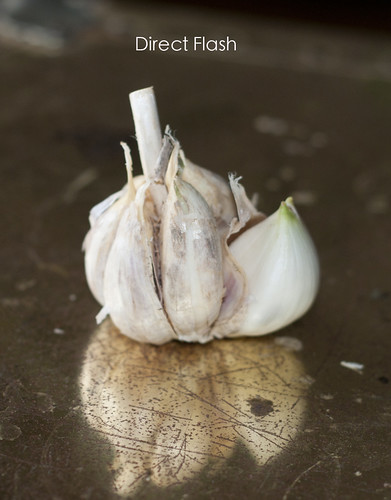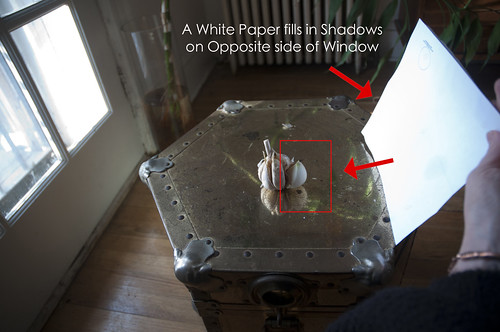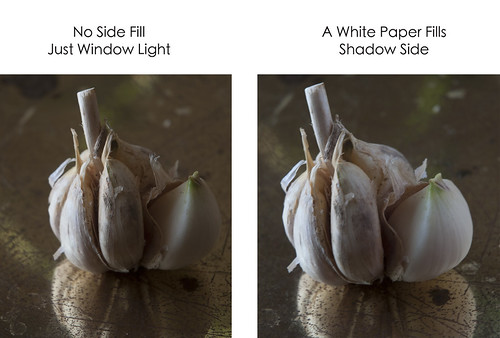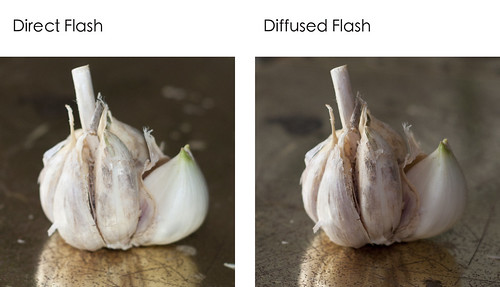 When shooting food, when should I use flash?
When shooting food, when should I use flash?
When using a little
point-and-shoot camera, my recommendation is to always use natural light when possible. The main thing you want to look at is the direction the light is coming from. Position the dish or food in a window so the light is coming from behind or from the side-- pictures tend to look more "professional" this way. If you're getting up close, put your macro (little flower) setting on. Turn your flash off and shoot on "P" setting (or "manual"). Auto setting will make your flash go off.

If the side opposite the window (shadow side) is too dark, you can fill in the shadows by holding up a white piece of paper to bounce some light onto the darker area. It really does make a difference!

The difference between using a paper to fill in the shadows on the side and not:

Having the food be back-lit is also a good option:

So often, we are wanting to shoot food at night in our homes or in restaurants when it's dark out. The ideal situation (for those of you with heftier cameras and
DSLRs) is to use a flash
like this and bounce the light off the ceiling, or
use a cord to create side light. I have a
Nikon D300 that does side light with a separate flash, wirelessly.
But if you're working with a point-and-shoot or a camera with a pop-up flash, you can diffuse the flash to make the light a little softer and not so hard on the food. You can place a tissue over the flash before shooting or use a piece of white paper at an angle below the flash to divert it upwards. The light will still hit the food, it'll just look softer, like this:

See the difference of on-camera flash vs. diffused flash? Huge!

Some other ideas for shooting indoors or at night:
*Use a desk lamp to light the food from the side or behind. You may need to put your camera on a tripod or stack of books to assure there is not motion blur. Turn your flash off and shoot on "P" setting (or manual). Again, the "Auto" setting will make your flash go off.
*If the flash is too bright on your point and shoot, try stepping back from the food and zooming in. The flash will not be as bright since you are farther away.
* If your
ISO is higher than 400, your image will start to look grainy.
*If your camera has manual settings, try shooting at F 2.8 (or the lowest number F stop your camera goes to). This will help achieve a blurry background.
Happy shooting!
*Erin Gleeson is a professional food photographer who teaches at the Fashion Institute of Technology in New York City. Her photos have been published in The New York Times, Gourmet and Edible Brooklyn. Culinography posts every Monday on Umamimart.
**Got a photography question? Email Culinography at erin@umamimart.com
 When shooting food, when should I use flash?
When using a little point-and-shoot camera, my recommendation is to always use natural light when possible. The main thing you want to look at is the direction the light is coming from. Position the dish or food in a window so the light is coming from behind or from the side-- pictures tend to look more "professional" this way. If you're getting up close, put your macro (little flower) setting on. Turn your flash off and shoot on "P" setting (or "manual"). Auto setting will make your flash go off.
When shooting food, when should I use flash?
When using a little point-and-shoot camera, my recommendation is to always use natural light when possible. The main thing you want to look at is the direction the light is coming from. Position the dish or food in a window so the light is coming from behind or from the side-- pictures tend to look more "professional" this way. If you're getting up close, put your macro (little flower) setting on. Turn your flash off and shoot on "P" setting (or "manual"). Auto setting will make your flash go off.
 If the side opposite the window (shadow side) is too dark, you can fill in the shadows by holding up a white piece of paper to bounce some light onto the darker area. It really does make a difference!
If the side opposite the window (shadow side) is too dark, you can fill in the shadows by holding up a white piece of paper to bounce some light onto the darker area. It really does make a difference!
 The difference between using a paper to fill in the shadows on the side and not:
The difference between using a paper to fill in the shadows on the side and not:
 Having the food be back-lit is also a good option:
Having the food be back-lit is also a good option:
 So often, we are wanting to shoot food at night in our homes or in restaurants when it's dark out. The ideal situation (for those of you with heftier cameras and DSLRs) is to use a flash like this and bounce the light off the ceiling, or use a cord to create side light. I have a Nikon D300 that does side light with a separate flash, wirelessly.
But if you're working with a point-and-shoot or a camera with a pop-up flash, you can diffuse the flash to make the light a little softer and not so hard on the food. You can place a tissue over the flash before shooting or use a piece of white paper at an angle below the flash to divert it upwards. The light will still hit the food, it'll just look softer, like this:
So often, we are wanting to shoot food at night in our homes or in restaurants when it's dark out. The ideal situation (for those of you with heftier cameras and DSLRs) is to use a flash like this and bounce the light off the ceiling, or use a cord to create side light. I have a Nikon D300 that does side light with a separate flash, wirelessly.
But if you're working with a point-and-shoot or a camera with a pop-up flash, you can diffuse the flash to make the light a little softer and not so hard on the food. You can place a tissue over the flash before shooting or use a piece of white paper at an angle below the flash to divert it upwards. The light will still hit the food, it'll just look softer, like this:
 See the difference of on-camera flash vs. diffused flash? Huge!
See the difference of on-camera flash vs. diffused flash? Huge!
 Some other ideas for shooting indoors or at night:
*Use a desk lamp to light the food from the side or behind. You may need to put your camera on a tripod or stack of books to assure there is not motion blur. Turn your flash off and shoot on "P" setting (or manual). Again, the "Auto" setting will make your flash go off.
*If the flash is too bright on your point and shoot, try stepping back from the food and zooming in. The flash will not be as bright since you are farther away.
* If your ISO is higher than 400, your image will start to look grainy.
*If your camera has manual settings, try shooting at F 2.8 (or the lowest number F stop your camera goes to). This will help achieve a blurry background.
Happy shooting!
*Erin Gleeson is a professional food photographer who teaches at the Fashion Institute of Technology in New York City. Her photos have been published in The New York Times, Gourmet and Edible Brooklyn. Culinography posts every Monday on Umamimart.
**Got a photography question? Email Culinography at erin@umamimart.com
Some other ideas for shooting indoors or at night:
*Use a desk lamp to light the food from the side or behind. You may need to put your camera on a tripod or stack of books to assure there is not motion blur. Turn your flash off and shoot on "P" setting (or manual). Again, the "Auto" setting will make your flash go off.
*If the flash is too bright on your point and shoot, try stepping back from the food and zooming in. The flash will not be as bright since you are farther away.
* If your ISO is higher than 400, your image will start to look grainy.
*If your camera has manual settings, try shooting at F 2.8 (or the lowest number F stop your camera goes to). This will help achieve a blurry background.
Happy shooting!
*Erin Gleeson is a professional food photographer who teaches at the Fashion Institute of Technology in New York City. Her photos have been published in The New York Times, Gourmet and Edible Brooklyn. Culinography posts every Monday on Umamimart.
**Got a photography question? Email Culinography at erin@umamimart.com



Comments (3)
Erin, this is handy, well explained and AWESOME! I already love this new Ask Culinography-coloumn!
Thanks, Anders!
Erin, this is really great!